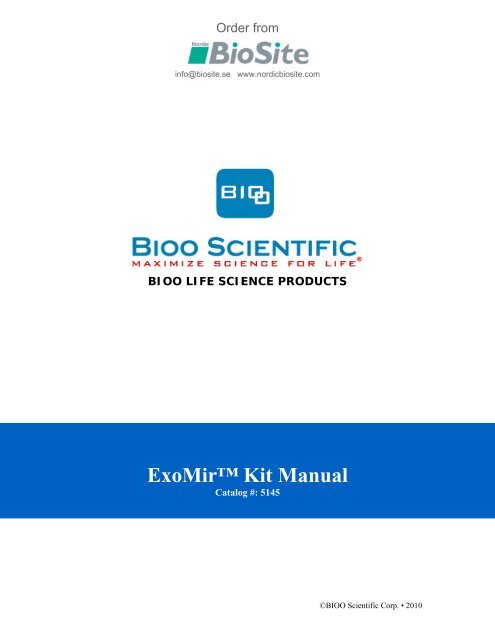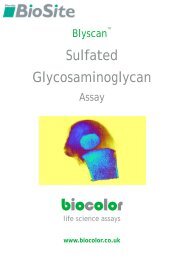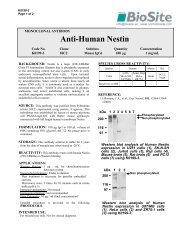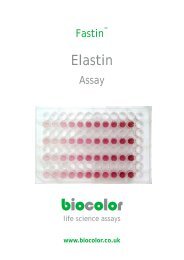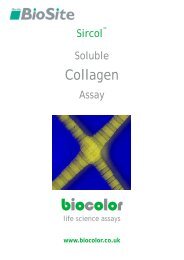ExoMir™ Kit Manual - Nordic Biosite
ExoMir™ Kit Manual - Nordic Biosite
ExoMir™ Kit Manual - Nordic Biosite
Create successful ePaper yourself
Turn your PDF publications into a flip-book with our unique Google optimized e-Paper software.
Order from<br />
info@biosite.se www.nordicbiosite.com<br />
BIOO LIFE SCIENCE PRODUCTS<br />
ExoMir <strong>Kit</strong> <strong>Manual</strong><br />
Catalog #: 5145<br />
©BIOO Scientific Corp. • 2010
TABLE OF CONTENTS<br />
GENERAL INFORMATION .......................................................................................... 1<br />
Application................................................................................................ 1<br />
Product Description.................................................................................. 1<br />
<strong>Kit</strong> Contents, Storage and Shelf Life......................................................... 2<br />
Required Materials Not Provided............................................................. 2<br />
Warnings and Precautions........................................................................ 2<br />
SAMPLE PREPARATION .............................................................................................. 3<br />
EXOMIR KIT PROTOCOL........................................................................................ 3<br />
Reagent Preparation................................................................................. 3<br />
Exosome Capture ...................................................................................... 4<br />
Lyse Captured Particles to Release RNA.................................................. 4<br />
RNA Extraction ......................................................................................... 5<br />
ADDITIONAL PROTOCOLS......................................................................................... 6<br />
Quantitation/Analysis of RNA from filters and Flow Through................. 6<br />
Modified RT-qPCR microRNA Protocol ................................................... 8<br />
TROUBLESHOOTING ................................................................................................... 9<br />
Filter clogs during sample filtration step................................................. 9<br />
Volume of Aqueous Phase Exceeds 0.75 mL............................................. 9<br />
Microparticle RNA is contaminated with cellular RNA ........................... 9<br />
REFERENCES.................................................................................................................. 9<br />
The ExoMir <strong>Kit</strong> is intended for laboratory use only, unless otherwise indicate. ExoMir is a Trademark of Bioo<br />
Scientific Corporation (BIOO).
GENERAL INFORMATION<br />
GENERAL INFORMATION<br />
ExoMir <strong>Kit</strong> <strong>Manual</strong> - 5145<br />
Application<br />
This kit is designed for the fractionation of, and RNA extraction from, exosomes and other<br />
microparticles in cell-free fluids. Recent research has highlighted the role of small membrane-bound<br />
particles such as exosomes and microvesicles, as intercellular mediators of biological information (refs<br />
1-12). Particles of various types and sizes are shed from solid tissues, leukocytes, and platelets, and<br />
find their way into the circulation and may also occur in other bodily fluids such as cerebrospinal fluid.<br />
Exosomes are among the smallest particles, with a size of ~ 30 – 100 nanometers. Exosomes<br />
originate when intracellular structures called multivesicular bodies fuse with the cell membrane and<br />
release their contents (exosomes) into the extracellular space. Multivesicular bodies are derived from<br />
the endosomal compartment, comprised of membrane-bound invaginations that can envelop and<br />
internalize exterior material. Microvesicles are larger particles and are shed directly from the cell<br />
membrane. Exosomes, microvesicles, and other membrane-bound micro particles are also shed into<br />
the culture media by eukaryotic cells propagated in vitro. Shed microparticles have been shown to<br />
transfer active mRNA and microRNA between cells. Release of microparticles may increase in number<br />
and type during pathological conditions, especially malignancies. Traditional methods for recovering<br />
exosomes involve centrifuging liquid samples at increasing centrifugal force, to sequentially pellet the<br />
larger and smaller particles. To recover exosomes, ultracentrifugation of samples at relative centrifugal<br />
force of at least 100,000 x g for several hours or more is required.<br />
Product Description<br />
The ExoMir kit uses an alternative approach, in which samples are passed over syringe filters to<br />
capture exosomes and larger membrane-bound particles. The filters are then flushed with an RNA<br />
extraction reagent to lyse the captured particles and release their contents. In the standard<br />
procedure, samples are passed over 2 filters connected in series, where the top filter has a larger pore<br />
size of approximately 200 nanometers to effectively capture larger particles such as apoptotic bodies<br />
and microvesicles, and the bottom filter has a smaller pore size of approximately 20 nanometers for<br />
capturing the exosomes. Examples of cell-free fluids that can be processed in this way include blood<br />
serum, cerebrospinal fluid, and eukaryotic cell culture media (“conditioned media”). After the sample<br />
has passed through, the filters are disconnected and separately flushed with BiooPure-MP to lyse<br />
the captured particles and release their contents. BiooPure-MP is a single-phase RNA extraction<br />
reagent containing guanidinium thiocyanate and phenol, which has been optimized to provide maximal<br />
recovery of the low-mass amounts of RNA in microparticles. Recovery of RNA is further improved by<br />
using the inert co-precipitant (linear acrylamide) included in the kit.<br />
The kit also contains Proteinase K, which can be used in an optional sample pre-treatment step to<br />
minimize filter clogging and non-specific signal from RNA not associated with particles. The benefit of<br />
including the Proteinase K treatment depends on the type and volume of the sample. In general, the<br />
enzymatic sample treatment is useful for samples having high protein content, such as blood serum,<br />
especially when a relatively large volume (> 10 mL) is processed. The Proteinase K treatment may<br />
also be beneficial for pre-treating large volumes (greater than ~ 30 mL) of samples with lower protein<br />
concentration, for example conditioned media from cultured cells.<br />
BIOO RESEARCH PRODUCTS • WWW.BIOOSCIENTIFIC.COM 1
<strong>Kit</strong> Contents, Storage and Shelf Life<br />
ExoMir <strong>Kit</strong> <strong>Manual</strong> - 5145<br />
The kit contains sufficient components to treat and fractionate 10 samples of cell-free fluids, using 2<br />
filters for each sample, and to extract RNA from both filters as well as from the flow-through filtrate.<br />
The shelf life of the ExoMir <strong>Kit</strong> is 12 months when stored properly.<br />
<strong>Kit</strong> Contents Amount Storage<br />
Syringe Filter Assembly 10 each of two-filter assemblies 20-25°C<br />
Proteinase K (lyophilized) 10 mg -20 ºC<br />
Proteinase K Resuspension Solution<br />
(contains 50% glycerol)<br />
1.0 mL -20 ºC<br />
BiooPure-MP RNA Isolation Reagent 30 mL 4 ºC<br />
Co-precipitant (inert linear<br />
polyacrylamide) (18 µg/µL)<br />
0.3 mL -20 ºC<br />
RNase-free water 7.5 mL 20-25°C<br />
RNA Resuspension Solution (0.15 mM<br />
EDTA in nuclease-free water)<br />
1.8 mL 20-25°C<br />
20 mL syringe 1 20-25°C<br />
3 mL 1 20-25°C<br />
Required Materials Not Provided<br />
• 1-Bromo-3-Chloropropane (BCP); suggested source: Sigma Life Science (cat #B9673). Store at<br />
room temperature.<br />
• Additional Luer Lock syringes of appropriate size, depending on sample volumes to be filtered<br />
• Additional 3 mL syringes used to flush the filters with BiooPure-MP (optional)<br />
• Waste collection tubes to catch filtrate (for example, 15 mL or 50 mL plastic tubes) (optional)<br />
• 1.5 mL microfuge tubes<br />
• P-1000, P-200, P-10 pipettors and tips; note, small-bore tips are required for last step<br />
• Isopropyl alcohol<br />
• Ethanol (may be denatured with 5% isopropanol)<br />
• Low-speed centrifuge for pelleting cells from media (optional)<br />
• Vortex mixer<br />
• Microcentrifuge capable of at least 14,000 x g or 12,000 rpm<br />
• Cabinet incubator at 37°C for Proteinase K treating samples (optional)<br />
• Heat block at 65°C for solubilizing RNA at end of procedure (optional but recommended)<br />
Warnings and Precautions<br />
BIOO strongly recommends that you read the following warnings and precautions. Periodically,<br />
optimizations and revisions are made to the components and manual. Therefore, it is important to follow<br />
the protocol included with the kit. If you need further assistance, you may contact your local distributor or<br />
BIOO at techsupport5@biooscientific.com.<br />
BiooPure-MP reagent contains phenol so be sure to wear lab coat, gloves, and safety goggles during<br />
the procedure. See MSDS for more information related to precautions and hazards associated with use<br />
of the BiooPure-MP reagent.<br />
BIOO makes no warranty of any kind, either expressed or implied, except that the materials from which its<br />
products are made are of standard quality. There is no warranty of merchantability of this product, or of the<br />
fitness of the product for any purpose. BIOO shall not be liable for any damages, including special or<br />
consequential damage, or expense arising directly or indirectly from the use of this product.<br />
BIOO RESEARCH PRODUCTS • WWW.BIOOSCIENTIFIC.COM 2
ExoMir <strong>Kit</strong> <strong>Manual</strong> - 5145<br />
SAMPLE PREPARATION<br />
SAMPLE PREPARATION<br />
Low-speed centrifugation of sample to remove intact cells (optional)<br />
To remove contaminating cells, centrifuge sample for 5 – 15 minutes at ~2,000 – 5,000 x g, ideally<br />
using a refrigerated centrifuge. The exact time and rcf (relative centrifugal force) to use is<br />
generally not critical, and can be adjusted according to sample type and volume. Avoid subjecting<br />
the sample to excessive rcf as this may rupture the cells. After centrifugation, remove the<br />
supernatant fluid by carefully decanting or aspirating it and save it for recovery of exosomes as<br />
described below. If the supernatant is aspirated, a small amount (~0.2 mL) may be left behind to<br />
avoid contamination with the pelleted cells.<br />
Pretreatment of sample with Proteinase K to minimize non-specific signal and prevent filter<br />
clogging (optional)<br />
This step is useful for minimizing clogging when filtering relatively large volumes (> 12 mL) of<br />
cell-free fluids that are viscous and/or contain high concentration of protein; a primary example of<br />
this type of sample is blood serum. Serum samples less than ~12 mL in volume can usually be<br />
filtered completely without this treatment, but RNA yields may be increased slightly by including it.<br />
The enzymatic treatment may also be useful for reducing clogging problems when filtering very<br />
large volumes (greater than about 30 mL) of less-viscous solutions, for example conditioned<br />
media recovered from mammalian cells cultured in vitro. The tendency for conditioned media<br />
samples to clog the filters varies according to type of cells, growth media, and density of cell<br />
growth; in some cases, Proteinase K treatment may be beneficial for conditioned media samples<br />
of less than 30 mL, or may not be needed for samples over 30 mL. The Proteinase K treatment<br />
also typically reduces the yield of RNA from the flow-through (the sample that has passed through<br />
the filters). This RNA may be nonspecifically associated with extracellular proteins. The RNA<br />
recovered from the flow-through typically shows a low signal of microRNA, with the signal varying<br />
according to the microRNA being detected.<br />
1. Add 100 µL of Proteinase K solution to the liquid sample and mix by inversion or gentle<br />
vortexing. In general, up to 20 mL of serum or 40 mL of tissue culture media can be treated.<br />
2. Incubate prep at 37ºC or room temperature for 30 minutes – 1 hour.<br />
EXOMIR KIT PROTOCOL<br />
Reagent Preparation<br />
EXOMIR KIT PROTOCOL<br />
• Prepare Wash Solution (75% ethanol) by adding 22.5 mL of ethanol to the bottle containing 7.5 mL<br />
of RNase-free water, provided with the kit, and mix thoroughly. Store at room temp.<br />
• Dissolve the Proteinase K, which is supplied as 10 mg of lyophilized powder, in the 1 mL of<br />
Proteinase K Resuspension Solution provided with the kit. Vortex briefly and pop-spin, and store<br />
the reagent at -20ºC after use. The Proteinase K concentration after dissolving is 10 mg/mL.<br />
BIOO RESEARCH PRODUCTS • WWW.BIOOSCIENTIFIC.COM 3
ExoMir <strong>Kit</strong> <strong>Manual</strong> - 5145<br />
Exosome Capture<br />
1. Load sample into syringe<br />
Standard sample volumes are 10 mL – 25 mL of conditioned media or 4 mL – 12 mL of blood<br />
serum. Maximum volumes of other types of samples should be determined empirically. The sample<br />
may be loaded into the syringe either by aspiration (inserting the open end of the syringe into the<br />
container of sample and retracting the plunger) or by removing the plunger, attaching the filters,<br />
pouring the sample into the barrel of the syringe, then re-inserting the plunger. If the second<br />
method is used, be sure that the filters are attached to the syringe before the sample is poured in,<br />
to prevent it from running out the end of the syringe. Use a syringe with a Luer-lok fitting, of<br />
appropriate size for the volume of sample to be filtered.<br />
2. Pass the sample through the filter stack<br />
Attach the inlet side of the top filter (marked with a yellow dot) to the outlet of the syringe if it was<br />
not already attached in Step 1. The filters should be tightened enough to ensure the connection is<br />
secure. Position the assembly over a reservoir to collect the flow-through if desired.<br />
Gently depress the plunger to pass the media through the filters. The sample should flow through<br />
at a rate of ~ 2-3 drops per second. If the filters clog, as indicated by slowed flow rate (< 1 drop per<br />
second), and excessive force being required to depress the plunger, do not attempt to force more<br />
sample through the filter.<br />
3. Remove residual fluid from the syringe filters<br />
After the sample has been filtered, remove the filter stack, retract the plunger of the syringe to the<br />
level of ~ 3 mL, then separately re-attach each filter and gently depress the plunger to force the<br />
residual fluid out of each syringe filter. There should be a visible clearing of the residual fluid from<br />
the top chamber of the filter housing. Complete removal of residual fluid from the filter disks is<br />
important to minimize the volume of aqueous phase recovered during the RNA extraction step,<br />
which will allow the RNA precipitation step to be carried out in a single 1.5 mL tube.<br />
4. Remove Filters<br />
After removing residual fluid, remove the filter disks from the syringe. The filter disks contain<br />
particles captured from the liquid sample.<br />
Lyse Captured Particles to Release RNA<br />
Note: Wear safely goggles during this step!<br />
1. Remove the plunger from a 3 mL syringe, attach the syringe barrel to a filter with captured particles,<br />
and load the syringe with 1 mL of BiooPure-MP.<br />
2. Position outlet of the filter disk over a 1.5 mL microfuge tube, then re-insert the plunger and slowly<br />
depress it to flush the filter with the BiooPure-MP reagent. Tilt the assembly if needed to allow the<br />
entire surface of the filter to contact the reagent. When the filter is saturated with reagent, slightly<br />
pump the plunger up and down several times to aid in complete mixing of the reagent with the<br />
trapped particles on the filter, then depress the plunger completely to recover all the BiooPure-MP<br />
lysate into the 1.5 mL tube.<br />
Note: The filter will remain green even after thorough recovery of the BiooPure-MP lysate.<br />
3. Repeat these steps to process the remaining filter disk. The preps may be stored at -20ºC at this<br />
step.<br />
BIOO RESEARCH PRODUCTS • WWW.BIOOSCIENTIFIC.COM 4
ExoMir <strong>Kit</strong> <strong>Manual</strong> - 5145<br />
Optional: To extract RNA from the Flow-Through (filtrate) or from the liquid sample prior to filtration,<br />
mix 0.25 mL of sample with 0.75 mL BiooPure-MP, and vortex thoroughly.<br />
RNA Extraction<br />
1. Add 100 µL of 1-Bromo-3-Chloropropane (BCP) to the lysate. Vortex vigorously for ~ 20 seconds<br />
to create an emulsion of the lysate with the BCP and store the preps at room temp for 5 - 10<br />
minutes before proceeding to the next step. Note: If the preps were frozen prior to beginning this<br />
step, thaw at room temperature before adding the BCP.<br />
2. Centrifuge preps for 15 minutes at 12,000 rpm, preferably at 4ºC.<br />
3. Remove aqueous phase (the colorless top phase) to fresh 1.5 mL tubes. The volume of aqueous<br />
phase is usually ~450 – 550 µL from filter samples and ~550 – 650 µL from flow-through samples.<br />
Do not remove more than 0.75 mL of aqueous phase per 1.5 mL tube, since this would not allow<br />
sufficient space for isopropanol precipitation in subsequent step. Avoid removing material from the<br />
interface or lower organic phase; however, the aqueous phase can be removed almost completely<br />
at this step since the amount of material at the interface is typically low compared to extractions<br />
from solid tissue.<br />
4. Add 9 µL of the co-precipitant provided with the kit to the aqueous phase and vortex thoroughly,<br />
and then store the prep at room temp for ~5 minutes. It is important to vortex thoroughly (~5 – 10<br />
seconds) to completely disperse the co-precipitant. Storing for a few minutes at room temp before<br />
adding the isopropanol improves recovery of RNA. If desired, pop-spin the preps (spin briefly in<br />
microfuge) to remove liquid from around rim of tube before opening it in the next step.<br />
5. Add isopropanol equal or slightly greater than the volume of aqueous phase and vortex thoroughly.<br />
This can generally be approximated as 0.55 mL of isopropanol. Store prep at -20ºC for at least 1<br />
hour to precipitate the RNA. Note, this is a stopping place; storage can be extended to overnight<br />
or longer if desired.<br />
6. To recover the RNA, centrifuge the prep for 15 - 20 minutes at maximum speed (at least 12,000<br />
rpm) in a microcentrifuge, preferably at 4ºC.<br />
7. Use P-1000 to remove supernatant fluid down to level of ~30 µL. Do not aspirate all the fluid, as<br />
this runs the risk of losing the pellet of RNA. Small pellets are usually but not always visible at this<br />
step. Decanting the supernatant fluid instead of aspirating at this step runs the risk of losing the<br />
RNA pellet.<br />
8. Wash the pellet with 0.9 mL of Wash Solution (75% ethanol). Vortex briefly but thoroughly enough<br />
to dislodge the pellet and ensure that the Wash Solution comes into contact with the entire inner<br />
surface of the tube.<br />
9. Centrifuge for 15 minutes at maximum speed (at least 12,000 x g), preferably at 4ºC.<br />
10. Carefully remove supernatant down to level of ~ 10- 20 µL. To minimize chance of aspirating the<br />
pellet, exercise care when removing the bottom portion of supernatant that lies directly above the<br />
pellet.<br />
11. Re-spin tubes at ~10,000 x g for ~ 5 seconds to collect all residual fluid at bottom of tube. Orient<br />
tubes with hinges facing outward.<br />
BIOO RESEARCH PRODUCTS • WWW.BIOOSCIENTIFIC.COM 5
ExoMir <strong>Kit</strong> <strong>Manual</strong> - 5145<br />
12. Use a fine-bore pipet tip (e.g. a P-10 tip) to completely remove all residual fluid from the bottom of<br />
the tube, taking care to avoid aspirating the pellet. A small white pellet should be visible.<br />
13. Resuspend pellet in 50 µL of RNA Resuspension Solution provided with the kit. After adding the<br />
solvent, vortex briefly and pop-spin to recover fluid at bottom of tube. The RNA may be<br />
resuspended in as little as 30 µL to maximize the concentration.<br />
14. Incubate the prep in 65ºC heat block for ~ 5 minutes to completely solubilize the RNA, then<br />
re-vortex and pop-spin. Store the RNA at -20ºC.<br />
ADDITIONAL PROTOCOLS<br />
ADDITIONAL INFORMATION<br />
Quantitation/Analysis of RNA from filters and Flow Through<br />
The RNA yields as determined by analysis on a Nanodrop 2000 are usually in the range of 0.8 – 3 µg<br />
per 4 – 10 mL human serum, and 1 µg – 4 µg per 12 mL – 30 mL of conditioned media. RNA yields are<br />
usually higher from the Top filter than the Bottom filter. The 260/230 ratios are usually less than 0.2;<br />
260/230 values greater than ~ 0.3 are indicative of contamination with BiooPure-MP extraction reagent,<br />
and the nanodrop concentrations may be overestimated in such samples. RNA content from unfiltered<br />
samples and from the post-filter Flow Through fraction is often similar to that recovered from the filters,<br />
as determined by Nanodrop analysis, however the microRNA signals from filter samples are usually<br />
higher by ~10 - 50 fold, as determined by qRT-PCR, compared to the corresponding unfiltered or Flow<br />
Through samples. Pretreatment of samples with RNase and Proteinase K prior to filtration usually<br />
leads to at least a several-fold reduction in microRNA signal from pre-filtered and Flow Through<br />
samples, with little or no reduction in signal from RNA trapped on the filters. Samples may be treated<br />
with 3 µg/mL of RNase A (not included with the kit) at 37ºC for 30 min – 1 hr, followed by treatment with<br />
Proteinase K as described in the protocol. The extent to which RNase A / Proteinase K pretreatment<br />
reduces microRNA signal in the unfiltered and Flow Through samples may vary according to the target<br />
microRNA being detected.<br />
The mass amount of RNA recovered from exosomes and other microparticles is too low to visualize by<br />
ethidium staining on agarose gels. The RNA can sometimes be detected by capillary electrophoresis<br />
on the Agilent Bioanalyzer, depending on the amount and type of sample. As shown in Fig. 1, the RNA<br />
lacks the typical 18S and 28S ribosomal RNA peaks seen in RNA extracted from cells and tissues; on<br />
a standard Agilent chip, the RNA migrates as a broad peak centered around 100 bases. Since<br />
microparticles are derived from the cytoplasmic cell compartment, they probably do not contain<br />
appreciable amounts of genomic DNA.<br />
BIOO RESEARCH PRODUCTS • WWW.BIOOSCIENTIFIC.COM 6
ExoMir <strong>Kit</strong> <strong>Manual</strong> - 5145<br />
Figure 1<br />
Analysis of ExoMir recovered RNA from human serum on<br />
Agilient Bioanalyzer. Shown are overlaid traces of RNA<br />
recovered from Top (red trace) and Bottom (blue trace) filters.<br />
Although the RNA is barely detectable on the Agilent, several<br />
microRNAs were readily detected by the RT-qPCR using 5% of<br />
each prep (see data presented in Table 1).<br />
Agilent analysis of RNA from Bottom Filter. RNA from 25<br />
mL of conditioned media pooled from several cell lines,<br />
captured using only the Bottom Filter.<br />
The best way to confirm recovery of RNA from microparticles is by reverse transcription-polymerase chain<br />
reaction (RT-PCR) or by RT followed by quantitative PCR (RT-qPCR). An example of data from an<br />
experiment designed to detect several microRNAs using the RT-qPCR stem-loop microRNA assays from<br />
Applied Biosystems/Life Technologies is shown in Table 1. The microRNA targets were detected using 2.5<br />
µL of input RNA, corresponding to 5% of the RNA recovered, in a protocol that was modified from that in the<br />
Applied Biosystems/Life Technologies instruction manual.<br />
Table 1. Detection of microRNAs in human serum from particles trapped on ExoMir filters, using<br />
RT-qPCR. In this experiment, 12 mL of pooled human serum was filtered through the Top and Bottom filters,<br />
without prior enzymatic treatment. Values are average Ct of duplicate PCRs from single RT.<br />
Sample miR-16 miR-150 miR-191<br />
RNA from Top Filter 23.66 23.50 29.10<br />
RNA from Bottom filter 27.96 26.92 34.69<br />
RNA from post-filtration Flow-through 30.51 31.35 39.91<br />
Negative control (input was 1.5 µL of<br />
no-RNA-added RT reaction)<br />
Not detected 32.69 Not detected<br />
BIOO RESEARCH PRODUCTS • WWW.BIOOSCIENTIFIC.COM 7
ExoMir <strong>Kit</strong> <strong>Manual</strong> - 5145<br />
Modified RT-qPCR microRNA Protocol<br />
1. Reverse Transcription step: (total reaction volume = 7.5 µL). Assemble first 5 components as<br />
Master Mix for each microRNA. Aliquot 5 µL of Master Mix to each 0.5 mL reaction tube, then add<br />
2.5 µL of sample RNA to each tube.<br />
Component Volume per 7.5 µL<br />
Source<br />
Reaction<br />
10X RT buffer 0.75 µL Bioo Scientific (cat# 521002)<br />
Nuclease-free water 1.7 µL Bioo Scientific (cat # 801001)<br />
4dNTP mix, 10 mM each 0.75 µL Bioo Scientific (cat # 370601)<br />
MML-V Reverse Transcriptase, 200 0.25 µL Bioo Scientific (cat # 521001)<br />
units/µL<br />
microRNA RT stem-loop primers 1.5 µL Applied Biosystem’s TaqMan<br />
microRNA assays<br />
Sample RNA 2.5 µL ~ 5% of RNA from ExoMir prep<br />
2. Incubate reactions in thermalcycler as follows: 30 minutes at 16ºC / 30 minutes at 42ºC / 5 minutes<br />
at 85ºC/ 5 minutes at 4ºC / soak at 18ºC).<br />
3. qPCR step (20 µL each reaction):<br />
Component Volume per 20 µL Source<br />
Reaction<br />
RT reaction 1.4 µL Above reaction<br />
TaqMan microRNA<br />
Assay<br />
1 µL Applied Biosystems Forward and Reverse<br />
PCR primers and the FAM-labeled TaqMan<br />
probe specific for each microRNA target<br />
Nuclease-free water 13.6 µL Bioo Scientific (cat # 801001)<br />
Hot DuroTaq 5x qPCR<br />
Mix (Rox Free)<br />
4 µL Bioo Scientific (cat #370401)<br />
Assemble reactions and run real-time profile according to Applied Biosystem Instruction <strong>Manual</strong>.<br />
BIOO RESEARCH PRODUCTS • WWW.BIOOSCIENTIFIC.COM 8
ExoMir <strong>Kit</strong> <strong>Manual</strong> - 5145<br />
TROUBLESHOOTING<br />
TROUBLESHOOTING<br />
Filter clogs during sample filtration step<br />
Recommended Action: Carry out optional low-speed centrifugation to remove intact cells as<br />
described in Protocol. Carry out optional Proteinase K pretreatment as described in Protocol. Reduce<br />
sample volume. If sample was blood plasma, consider using serum instead of plasma. To use serum,<br />
collect blood without anticoagulant and allow blood to clot, then centrifuge to fractionate sample into<br />
cellular components and non-cellular serum, and remove serum for use. Serum is depleted of blood<br />
clotting factors, which may help to avoid clogging. Serum samples that are turbid usually indicate<br />
presence of high concentration of lipids, and these may not be suitable for filtration, even after<br />
Proteinase K treatment. Such samples can sometimes be processed using filters with larger pore size<br />
(700 nanometers), which are available from Bioo Scientific as a separate product (please contact<br />
techsupport5@biooscientific.com)<br />
Volume of Aqueous Phase Exceeds 0.75 mL<br />
(Volume of aqueous phase at removed exceeds 0.75 mL, so that the RNA cannot be<br />
precipitated in single 1.5 mL tube)<br />
Recommended Action: Completely remove residual fluid from the syringe filter disks before flushing<br />
with BiooPure-MP. Traces of fluid that may remain in the filter disk can be removed by tapping the<br />
outlet port onto paper towels. Precipitation of the RNA in 2 mL tubes is not recommended because the<br />
shape of the tube does not taper to a point, so the RNA/co-precipitant does not form a visible pellet;<br />
also, removing the last traces of supernatant fluid from 2 mL tubes without disturbing the RNA is<br />
difficult.<br />
Microparticle RNA is contaminated with cellular RNA<br />
(The microparticle RNA is contaminated with cellular RNA, which can be seen if the<br />
Agilent Bioanalyzer trace shows presence of peaks of large ribosomal RNAs)<br />
Recommended Action: Carry out optional low-speed spin to remove cells, as described in Part A.<br />
Contaminating cellular RNA is generally not due to lysis of cells, because most cell-free fluids have<br />
high levels of endogenous RNase that will degrade extracellular RNA which is not protected in<br />
membrane-bound particles.<br />
REFERENCES<br />
REFERENCES<br />
1. Lung Cancer Secreted Microvesicles: Underappreciated modulators of microenvironment<br />
in expanding tumors. Wysoczynski M and Ratajczak M, International J Cancer 125(7):<br />
1595-1603, Oct. 2009.<br />
2. Delivery of MicroRNA-126 by apoptotic bodies induces CXCL 12-dependent vascular<br />
protection. Zernecke A et al., Science Signaling 2(100) ra81, Dec. 2009.<br />
3. Exosome-mediated transfer of mRNAs and microRNAs is a novel mechanism of genetic<br />
exchange between cells. Valadi H et al. Nature Cell Biol. 9(6):654-659. Jun 2007.<br />
4. Cellular microvesicle pathways can be targeted to transfer genetic information between<br />
BIOO RESEARCH PRODUCTS • WWW.BIOOSCIENTIFIC.COM 9
non-immune cells. Skinner A et al PLoS One 4(7): e6219, July 2009.<br />
ExoMir <strong>Kit</strong> <strong>Manual</strong> - 5145<br />
5. Itinerant exosomes: emerging roles in cell and tissue polarity. Lakkaraju A and<br />
Rodriguez-Boulan E. Trends Cell Biol. 18(5): 199-209, May 2008.<br />
6. Microparticles as regulators of inflammation. Distler J et al. Arthritis and Rhemmatism<br />
52(11):3337-3348. Nov 2005.<br />
7. Highlights of a new type of intercellular communication: microvesicle-based information<br />
transfer. Pap E. et al. Inflammation Res. 58(1): 1-8. Jan 2009.<br />
8. MicroRNA signatures of tumor-derived exosomes as diagnostic biomarkers of ovarian<br />
cancer. Taylor D and Gercel-Taylor C.<br />
9. Detection of microRNA expression in human peripheral blood microvesicles. Hunter M et al.<br />
PLos One 3(11): e3694. Nov. 2008.<br />
10. Transfer of microRNAs by embryonic stem cell microvesicles. Yuan A et al. PLoS One<br />
4(3):e4722. March 2009.<br />
11. Do neural cells communicate with endothelial cells via secrtory exosomes and<br />
microvesicles? Smallheiser N. Cardiovascular Psychiatry and Neurology ID 383086, 2009.<br />
12. Human liver stem cell-derived microvesicles accelerate hepatic regeneration in<br />
hepatectomized rats. J Cellular and Molecular Medicine doi 10.1111/j.1582-4934, 2009.<br />
Bioo Scientific Corporation<br />
3913 Todd Lane Suite 312<br />
Austin, TX 78744 USA<br />
Tel: 1.888.208.2246<br />
Fax: (512) 707-8122<br />
Made in USA<br />
BIOO Research Products Group<br />
info@biooscientific.com<br />
techsupport5@biooscientific.com<br />
www.biooscientific.com<br />
BIOO RESEARCH PRODUCTS • WWW.BIOOSCIENTIFIC.COM 10


